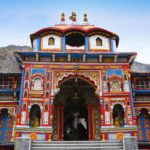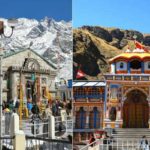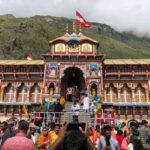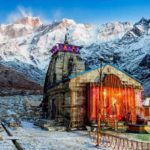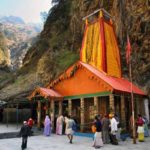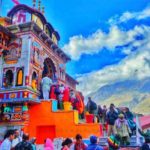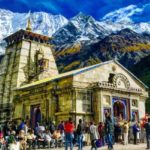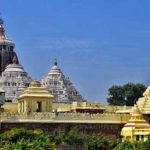Badrinath Travel Guide is a glorious sight just as the most significant of all the Char Dhams. Lakhs of devotees come each year to this consecrated Badrinath town to look for favours and to get a look at the renowned sanctuary of Shri Badrinath Ji. Badrinath is one of the prominent Shrine which is a piece of both Chota Char Dham and Char Dham in India. Badrinath is one among four journey focuses on four corners of India.In the North, Badrikashram (Badrinath Temple), Rameshwaram in the South, Dwarka Puri in the West, and Jagannath Puri in the East were among them. Read on for a brief Badrinath travel guide.
Without a doubt, no one knows exactly how old the Badrinath temple was is, Although it is possible to follow Badrinath as a heavenly spot as far back as the Vedic Age in India, which began around 1,500 B.C. During this period , due to its ground-breaking profound vitality, the area, known as Badrikashram in Hindu sacred texts, attracted numerous holy people and sages Although the Vedas (the most punctual Hindu sacred texts) did not contain notices of sanctuaries, it is said that some Vedic songs were first sung by sages who possessed the area.
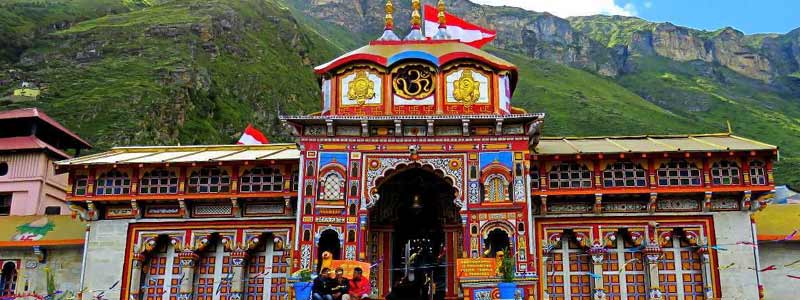
Other sacred legends and fantasies related to Badrinath are numerous As one of them indicated, during his long reward, Goddess Lakshmi gave Lord Vishnu berries (or appeared as a berry tree to furnish him with a cover from the cold). Henceforth, from Badri (a Sanskrit word for the Indian Jujube tree) and Nath (which means master), Badrinath gets its name.
In Badrinath, while travelling around, You ‘d probably need a tour guide from Badrinath to better explore the places. On the journey, Badrinath Temple is normally visited along with various sacred sites that make up the Char Dham in Uttarakhand. Out of the four, it is the most available temple, and one of India’s most mainstream temples. The number of explorers has grown to more than 1 million each year. In general, however, the temple wasn’t so easy to reach. There was no street access prior to 1962 and people needed to walk over the mountains to arrive.
In the name of Lord Vishnu alone, Badrinath is also part of the five popular shrines often referred to as ‘Panch Badri’. These are the
- Vishal Badri – The temple at Badrinath
- YogaDhyan Badri Pandukeshwar
- Bhavishya Badri at Subain
- Vridh Badri in Animath
- Adi Badri at a distance of 10.6 miles from Karnaprayag
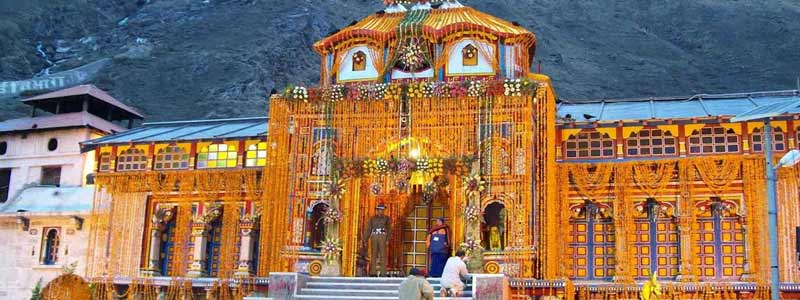
History of Badrinath
In this historical temple of Badrinath, two mythological storeys are popular. God Vishnu was meditating in the harsh cold weather in the Himalayas, according to one Hindu legend. To protect him, Goddess Lakshmi took the form of the Badri(Jujube) tree. He was pleased when Lord Vishnu awoke, and thereby named the place Badrika Ashram.
While the Vishnu Puranas, one of Hinduism’s ancient texts, has another version of Badrinath ‘s origin. There were two sons of Dharam, Nar, and Narayan, as per the literature, which are the present names of two existing mountains. They were looking for an ideal hermitage location and chose this location with hot and cold springs behind the Alaknanda river.
In Mahabharata, Skanda Purana, and Bhagavata Purana, Badrinath temple and its location are also directly located. Although the temple is located in northern India, with a traditional Nambudiri Brahmin, the head priest is still selected from the southern state of Kerala. This tradition was started by Adi Shankaracharya. When Dandi sanyasis, the last of the shiva ascetics, died without an heir The local king invited the non-ascetic Nambudiri community in the 18th century, a group which still continues its belief in modern Southern India. They are selected in consultation with each other by the royal families of Travancore and Garhwal.
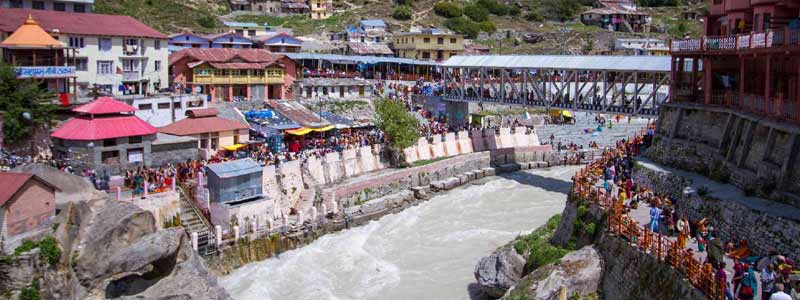
Places To Visit In Badrinath
Places To Visit In Badrinath For every sort of visitor, there are different places of interest in Badrinath. While Swargarohini, Laxmi Van, Vasu Dhara Falls, Bheem pul, Satopanth, Tapt Kund, Panch Shila, Narad Kund, Brahma Kamal are for pilgrims, Neelkanth Parvat and Vasudhara are for the lovers of nature at the same time.
Badrinath Temple
This temple has been present since the Vedic periods, which were mainly established in the 8th century by Adi Shankaracharya, according to history. However, three centuries ago, the current structure of the temple was built by the kings of Garhwal. This temple’s presiding deity is Lord Vishnu. The temple ‘s characteristics are that it is constructed like a cone with a small cupola of a golden bull and a spire The temple complex goes up to about five metres in height. The temple houses nearly 15 idols, such as the idols of Lakshmi, the wife of Vishnu, Garud, his mount, and Lord Shiva, his wife Parvati, and son Ganesha. The main idol of Lord Vishnu takes the meditation pose here. The temple is divided into three regions that include the principal deity of the Garbha Griha, A Darshan Mandap for the Puja and a Sabha Mandap to assemble devotees. Additionally, the main gate at the entrance lends the temple beauty. The temple is open only during the summers.
Brahma Kapa
Brahma Kapal Ghat is situated towards north of the Badrinath temple at a distance of about just 100mts. The Brahma Kapal is a flat platform on the banks of the Alakananda River, where Lord Brahma is believed to reside. It is here that Lord Shiva was relieved from his curse of killing Brahma, and Brahma ‘s head also fell from Brahma Kapal’s Shivas trident. Offering sraddha to ancestors and paying homage and rituals to the departed souls is customary for devotees.
Charan Paduka
This is a beautiful rock 3380 feet from the ground level at an altitude that gives you a sense of clarity and calmness. This rock’s most important feature is that it holds Lord Vishnu ‘s footprints. While the path to Charanpaduka is quite risky, it is worth taking up because it is believed that the darshan of the Lord’s footprints will assist the devotees to come out of all the ailments and difficulties in life.
Narad Kund
Narad Kund is one of Badrinath ‘s popular tourist and religious spots, thronged by pilgrims to take a holy dip in the kund before they go for the darshan. It is said that there is a hot spring in the Narad Kund that makes the water warm. History also says that it was from here that the idol of Lord Vishnu was recovered by Adi Sankara. By default, the Narad Kund is surrounded by a projected rock angles which breaks the flow of the water current and provides a nice atmosphere for a bath.
Neelkanth
The peak of Neelkanth is in the form of a pyramid and is at an altitude of about 6,597 metres, attracting a number of tourists for its magnificent natural views. Nature is designed in such a way that the Badrinath shrine overlooks this peak and opens up to the snow-clad peaks. The Neelkanth peak is known as the Queen of Gharwal, which is suitable for the scenic spot’s captivating beauty.
Sheshnetra
This is one of Badrinath‘s most remarkable visiting spots because it is believed that Lord Vishnu takes his asylum on a snake named Anantha Shesha. This location is marked with one eye by a large stone, snake Sheshnetra. The most interesting feature of this spot is the very realistic imprints on the rock. It is a beautiful environment with the majestic Alakananda River on the Sheshnetra The backdrop gives a calming sensation of serenity. It is also said that Sheshnetra guards Lord Badrinath’s holy shrine.
Tapt Kund
The holy abode of Lord Agni is supposed to be Tapt Kund, a natural spring located above the riverbank. The water temperature is always quite hot, and a holy dip in this helps the devotees to come out of their sin and impart a new life and energy. In addition to its therapeutic advantage, this hot water spring in the middle of the Himalayan snowy peaks is quite a wonderful one.
Panch Badri
Panch Badri, panch meaning five, forms the main temple of Badrinath along with four other temples or Badris. The temples of these other badris are located a few kilometres from Badrinath ‘s temple. At Padukashwar (1920 mts), Yog Dhyan Badri is located 24 km from here. Before retiring, the Pandavas handed over their empire here to King Parikshit. The second Badri at Subain is Bhavishtya Badri near Tapovan. Bhavishya Badri means Badri of the future. It is believed that a time in history will come when the current route to Badrinath will become inaccessible and Bhavishya Badri will be admired instead. The remnants of 16 temples are Adi Badri and can be reached from Karnprayag. And finally, it is believed that Vriddha Badri, located 7 km from Joshimath, was here several years before Adi Shankarcharya existed idol of Badrinath was enshrined and worshipped here.
How to Reach Badrinath
By Air: Jolly Grant Airport in Dehradun, about 314 km away, is the nearest airport to Badrinath. To make it to the desired destination, one can hire a taxi for another trip.
By Rail: Haridwar is the closest railhead to arrive at Badrinath. Following stations are well connected to the main cities of India:
Haridwar- 302 km
Dehradun- 327 km
By Road: Badrinath is well connected with main places of Uttarakhand by excellent roads. Bus and taxi service is also available from the most important destinations including Haridwar, Srinagar, Rudraprayag, Chamoli, Pauri, Ukhimath and Karnaprayag to get to Badrinath.

